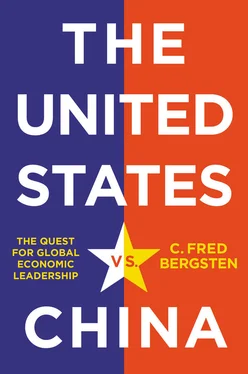1 ...6 7 8 10 11 12 ...17 There are already numerous indications of China’s impact on the world, and indeed on the United States itself. China has already pushed other powerful countries, including the United States, to alter their own economic policies. The United States – especially under President Trump, but pre-dating him in some cases and post-dating him in a few – has “fought fire with fire” by adopting restrictive trade, investment, and industrial policies that considerably deviate from its traditional market-based approaches. It raised substantial tariffs against a large volume of imports from China (and other countries), sharply tightened its controls over technology exports, limited Chinese direct investment in the United States, discouraged US investment in China, rejected Chinese students and tourists, and adopted preferential industrial policies and extensive “Buy America” preferences of its own. After decades of supporting a global Internet of open systems, the United States now envisions a restricted Internet that is cordoned off by governments “adopting the Chinese model” (Zakaria 2020).
Many countries, especially in Asia but ranging well beyond it, have emulated Chinese policies such as currency manipulation and industrial supports via state-owned enterprises (SOEs). BRI conditions (or lack thereof) may increasingly dominate traditional multilateral development bank (MDB) conditions in some recipient countries. More broadly, the world is becoming both less market oriented and less democratic – not solely due to China, but certainly influenced by it.
China has also moved to the center of the international bargaining table on a wide range of issues. As a dominant player in the world economy, it had to be invited to join (and, indeed, help to lead) the response to the global financial crisis in 2008–9. Given China’s own institutional preferences, this in turn propelled the G-20, including other emerging markets, to supremacy over the G-7 of solely high-income countries as the chief steering committee for the world economy. China was able to lever these developments to subsequently increase its role in the governance structure of the IMF.
As the world’s largest polluter, China was an essential participant in global efforts to address climate change and played a central role in the Copenhagen conference in 2009 and the Paris Agreement in 2015. As a repressive country, it is increasingly driving the evolution of international rules and norms to govern the Internet. It will have to play a major role in any effective international response to the coronavirus and future pandemics. As noted already, China has also been active in creating new international institutions; one astute observer suggests that “China is meticulously constructing an alternative and parallel global institutional architecture … motivated by Beijing’s long-standing dissatisfaction with what it perceives to be inherent pro-Western biases of the post-World War II institutional architecture” (Shambaugh 2016).
Until recently – and perhaps still – it could reasonably be assumed that any Chinese ascent toward global economic leadership would take place gradually over a period of years or, more likely, decades. China traditionally takes a long-run view and clearly believes that time is on its side as its economy catches up to, and in absolute terms increasingly exceeds, that of the United States, and eventually perhaps even the hegemonic coalition as a group. Deng Xiaoping famously counseled that China “hide its might and bide its time,” to avoid alarming the rest of the world, and that guidance has driven Chinese foreign policy, at least until recently. “The China dream” itself frequently envisages the country assuming a central global role by 2049, more than a quarter of a century away. President Xi has recently reiterated that target date.
Most Chinese leaders have also wanted to avoid disruption of the global system to avoid jeopardizing their overriding priorities: the domestic development agenda and the dominance of the CCP. They have preferred to avoid confrontation with the United States. For its part, the United States, before and after President Trump, has wanted to retain its global leadership role despite faltering increasingly in the exercise of the accompanying responsibilities.
There may nevertheless be a “Thucydides trap” for the world economy. That theory posits inherent conflict between a rising power, in this case China, and an incumbent power, in this case the United States. The economic-only corollary would presumably be less apocalyptic than pure Thucydides. 2However, we are already seeing trade and technology wars between China and the United States. Renewed Cold War has become a real possibility and is promoted by important factions in both countries. Major systemic conflict is clearly possible due to the rise of China, abetted by the flagging will of the United States.
Some analysts perceive a close parallel between today and the systemic transformation of the late nineteenth and early twentieth centuries, when Wilhelmine Germany challenged Great Britain for global leadership. Kissinger (2014) recalls the Crowe Memorandum, produced by the British Foreign Office in 1907, that posited an existential threat to British interests from the rise in German capabilities, whatever its contemporary intentions. 3There is an “uncanny resemblance” to the current situation (Brunnermeier, Doshi, and James 2018):
Both rivalries take place amidst the emergence of economic globalization and explosive technological innovations. Both feature a rising autocracy with a state-protected economic system challenging an established democracy with a free-market economic system. And both rivalries feature countries enmeshed in profound interdependence wielding tariff threats, standard-setting, technology theft, financial power, and infrastructure investment for advantage … Both countries (Germany then and China now) believed that catching up with established powers required state-directed economic and technology programs. Fair competition was beside the point and national strength was the goal under both Otto van Bismarck and Deng Xiaoping, to the eventual detriment of relations with free-market Great Britain and the United States. 4
Five developments over the past decade or so raise the possibility of a more rapid transformation of global economic leadership or even a Chinese “dash for dominance.” First, the global financial crisis, which originated in the United States and whose second major phase emanated from its closest allies in Europe, and the responses to it were viewed by many in China (and elsewhere around the world) as an inflection point in the evolution of the global economy. The episode both generated new self-confidence in China and shook global confidence in the traditional leading countries and their market-based economic model, and even in their democracies. China, in particular, began to question the wisdom and judgment of its “previous teacher,” the United States, and was emboldened to think even more aggressively about its own global role (Paulson 2011; Geithner 2015). The highly successful conduct of the Beijing Olympics in 2008 added further to China’s self-confidence and hubris in this pivotal period.
The success of China’s recovery and its provision of more than one quarter of all global growth for the succeeding decade, and its rise to the no. 1 position in global GDP (at PPP) and world trade in the years after the crisis, validated its model of state capitalism in its own mind and in other quarters. They added substantially further to its impact around the world.
Second, China has modified its own development strategy in ways that potentially escalate its challenge to the existing global order. Though always retaining an important role for the state, China appeared to be moving toward increased reliance on the market, and even its version of free enterprise, from the outset of its economic reforms in the late 1970s at least through the middle 2000s (Lardy 2014). It has continued to declare its commitment to such a path – indeed, escalating its rhetoric to speak of a “decisive” role for the market as late as 2013.
Читать дальше












